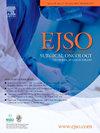早期宫颈癌患者双侧前哨淋巴结标测失败的相关因素:一项意大利回顾性多中心研究
IF 3.5
2区 医学
Q2 ONCOLOGY
引用次数: 0
摘要
目的本研究的主要目的是评估使用吲哚菁绿(ICG)进行前哨淋巴结(SLN)活检的明显早期宫颈癌患者双侧定位失败的相关因素。次要目的是敏感性、阴性预测值和淋巴结复发率。方法回顾性多中心研究。本研究纳入2015年4月至2023年12月间行原发性手术并尝试ICG注射SLN作图的FIGO期IA1 ~ IIA2宫颈癌患者。进行适当的统计分析以评估研究终点。时间框架分为第一期2015年4月- 2019年12月,第二期2020年1月- 2023年12月。结果共纳入618例患者。531名(85.9%)妇女(其中36名(5.8%)接受宫颈再注射ICG)实现了双侧SLN定位。SLN单侧定位和定位失败分别为71例(11.5%)和16例(2.6%)。灵敏度为85.9%,阴性预测值为98.1%,准确率为98.3%。单侧测图患者的假阴性率为4/68(5.9%),双侧测图患者的假阴性率为6/316 (1.9%)(p = 0.061)。bmi30 (p = 0.001)和病理性肿瘤直径20 mm (p = 0.023)是唯一与双侧SLN定位失败独立相关的因素。ICG再注射使双侧SLN检出率由81.3%提高到85.9%。在第一和第二研究期间,双侧检出率分别为82.8%和88.3% (p = 0.061)。所有患者3年DFS和OS分别为89.7%和98.2%。任何SLN标测组有7例(1.2%)淋巴结复发,而未标测组有1例(6.3%)淋巴结复发(p = 0.190)。结论高BMI和较大肿瘤与ICG双侧SLN定位失败相关。ICG宫颈再注射增加了双侧测图率。接受SLN标测的患者与标测失败的患者无淋巴结复发差异。本文章由计算机程序翻译,如有差异,请以英文原文为准。
Factors associated with bilateral sentinel lymph node mapping failure using indocyanine green in patients with apparent early-stage cervical cancer: An Italian retrospective multi-center study
Objective
The primary aim of this study was to assess the factors associated with bilateral mapping failure in patients with apparent early-stage cervical cancer undergoing sentinel lymph node (SLN) biopsy using indocyanine green (ICG). Secondary aims were sensitivity, negative predictive value and lymph node recurrence.
Methods
Retrospective multi-center study. Patients with cervical cancer apparent FIGO stage IA1 to IIA2, treated with primary surgery between 04/2015 and 12/2023 and undergoing SLN mapping attempt with ICG injection, were included. Appropriate statistical analysis was performed to assess study endpoints. Timeframe was divided in first period 04/2015–12/2019 and second period 01/2020–12/2023.
Results
618 patients were included. Bilateral SLN mapping was achieved in 531 (85.9 %) women (36 of them, 5.8 %, underwent cervical re-injection of ICG). SLN unilateral mapping and mapping failure was observed in 71 (11.5 %) and 16 (2.6 %), respectively. The sensitivity, negative predictive value and accuracy were 85.9 %, 98.1 % and 98.3 %, respectively. False negative rate was 4/68 (5.9 %) in patients with unilateral mapping versus 6/316 (1.9 %) in those with bilateral mapping (p = 0.061). BMI>30 (p = 0.001) and pathologic tumor diameter >20 mm (p = 0.023) were the only factors independently associated with bilateral SLN mapping failure. ICG re-injection increased the rate of bilateral SLN detection from 81.3 % to 85.9 %. The rate of bilateral detection was 82.8 % versus 88.3 % in the first versus second study period, respectively (p = 0.061). 3-year DFS and OS in all patients were 89.7 % and 98.2 %, respectively. Seven patients (1.2 %) had lymph node recurrence in the group of any SLN mapping versus 1 (6.3 %) in no mapping group (p = 0.190).
Conclusion
High BMI and larger tumors were associated with bilateral SLN mapping failure using ICG. The ICG cervical re-injection increased the rate of bilateral mapping. No lymph node recurrence difference was found in patients undergoing SLN mapping versus patients with mapping failure.
求助全文
通过发布文献求助,成功后即可免费获取论文全文。
去求助
来源期刊

Ejso
医学-外科
CiteScore
6.40
自引率
2.60%
发文量
1148
审稿时长
41 days
期刊介绍:
JSO - European Journal of Surgical Oncology ("the Journal of Cancer Surgery") is the Official Journal of the European Society of Surgical Oncology and BASO ~ the Association for Cancer Surgery.
The EJSO aims to advance surgical oncology research and practice through the publication of original research articles, review articles, editorials, debates and correspondence.
 求助内容:
求助内容: 应助结果提醒方式:
应助结果提醒方式:


